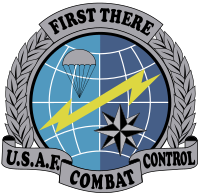| U.S. Air Force Combat Control Team | |
|---|---|
 U.S. Air Force Combat Control flash (colorized) | |
| Active | January 1953 – present |
| Country | |
| Branch | |
| Type | Special Operations Force |
| Role | Airfield Assault Zone establishment, special reconnaissance, Air traffic control, fire support |
| Size | 360[1] |
| Part of | |
| Nickname(s) | CCT, Air Commando |
| Motto(s) | "First There"[2] |
| Color of Beret | Scarlet Red |
| Engagements | Korean War Vietnam War Invasion of Grenada Invasion of Panama Gulf War Operation Gothic Serpent Afghanistan War Iraq War |
| Insignia | |
| Combat Controller scarlet beret with beret flash |  |
The United States Air Force Combat Control Teams, singular Combat Controller (CCT) (AFSC 1Z2X1), are an elite special operations force (specifically known as "special tactics operators") who specialize in all aspects of air-ground communication, as well as air traffic control, fire support (including rotary and fixed-wing close air support), and command, control, and communications in covert, forward, or austere environments.[2][3]
Assigned to Special Tactics Squadrons and Special Tactics Teams along with Pararescuemen, Special Operations Reconnaissance, and Tactical Air Control Party (TACP) operators, Combat Controllers are an integral part of Air Force Special Operations Command (AFSOC), the Air Force component of United States Special Operations Command (USSOCOM), and of Joint Special Operations Command (JSOC). Trained in underwater and maritime operations, freefall parachuting, and many other deployment methods, Combat Controllers are often assigned individually or as a team to Army Special Forces, Army Ranger, Navy SEAL, and Delta Force to provide expert airfield seizure, airstrike control, and communications capabilities.[4]
Combat Controllers are FAA-certified air traffic controllers and maintain proficiency throughout their career.[2] Along with TACPs, many Combat Controllers also qualify and maintain proficiency as joint terminal attack controllers (JTACs) where they call in and direct air strikes, close air support and fire support.[5] Out of the seven Air Force Crosses awarded since the Global War on Terror started in 2001, five have been awarded to Combat Controllers for extraordinary heroism in combat. CCTs provided vital intelligence and deployed with joint air and ground forces in support of direct action, counter-terrorism, foreign internal defense, humanitarian assistance, special reconnaissance, austere airfield, and combat search and rescue missions.
- ^ Donna Miles. "Combat controllers play key role in war on terror". Af.mil. Retrieved 11 May 2013.
- ^ a b c "Combat Control Fact Sheet". Air Force Special Operations Command. United States Air Force. Archived from the original on 28 June 2013. Retrieved 13 January 2013.
- ^ "Combat Control career description". Archived from the original on 5 April 2014. Retrieved 12 January 2013.
- ^ "Combat Controllers Overview". SOFREP. Archived from the original on 13 February 2014. Retrieved 11 May 2013.
- ^ Donna Miles (23 April 2004). "Combat Controllers Play Key Role in Terror War". American Forces Press Service. Archived from the original on 15 January 2014. Retrieved 12 January 2013.